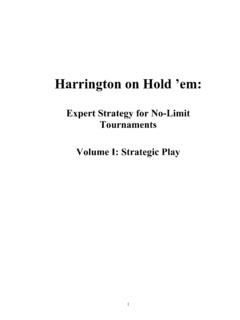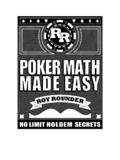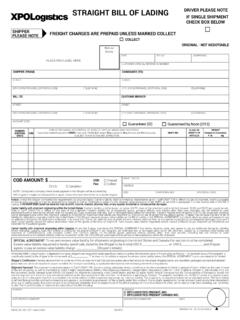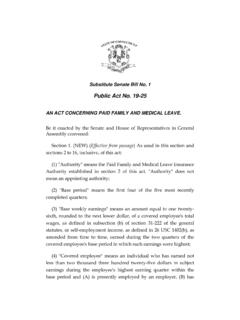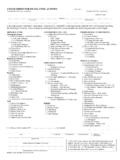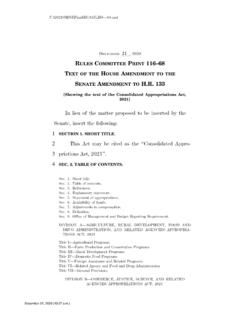Transcription of The Mathematics of Poker
1 _____ THE Mathematics OF Poker 1 _____ THE Mathematics OF Poker 2 Other ConJelCo titles: Cooke's Rules of Real Poker by Roy Cooke and John Bond Hold'em Excellence by Lou Krieger How to Play Like a Poker Pro by Roy Cooke and John Bond How to Think Like a Poker Pro by Roy Cooke and John Bond Internet Poker by Lou Krieger and Kathleen Watterson Mastering No-Limit Hold'em by Russ Fox and Scott T. Harker More Hold'em Excellence by Lou Krieger Real Poker II: The Play of Hands J 992-1999 (2nd ed.) by Roy Cooke and John Bond Serious Poker by Dan Kimberg Stepping Up by Randy Burgess The Home Poker Handbook by Roy Cooke and John Bond Why You Lose at Poker by Russ Fox and Scott T. Harker Winning Low-Limit Hold'em by Lee Jones Winning Omaha/8 Poker by Mark Tenner and Lou Krieger Winning Strategies for No-Limit Hold'em by Nick Christenson and Russ Fox Video Poker Optimum Play by Dan Paymar Software StatKing for Windows _____ THE Mathematics OF Poker 3 The Mathematics of Poker Copyright 2006 by bill Chen and Jerrod Ankenman All rights reserved.
2 This book may not be duplicated in any way or stored m an information retrieval system, without the express written consent of the publisher, except in the form of brief excerpts or quotations for the purpose of review. Making copies of this book, or any portion, for any purpose other than your own. is a violation of United States copyright laws. Publisher's Cataloging-in-Publication Data Chen, bill Ankenman, Jerrod The Mathematics of Poker x,382p. ; 29cm. ISBN-13: 978-1-886070-25-7 ISBN-10:1-886070-25-3 I Title. Library of Congress Control Number: 2006924665 First Edition 5 7 9 8 6 Cover design by Cat Zaccardi Book design by Daniel Pipitone Digital production by Melissa Neely ConJeiCo LLC 1460 Bennington Ave Pittsburgh, PA 15217 [412] 621-6040 Errata, if any, can be found at _____ THE Mathematics OF Poker 4 5 6 8 Part I: Basics Chapter 1 Decisions Under Risk: Probability and 15 Chapter 2 Predicting the Future: Variance and Sample 24 Chapter 3 Using All the Information: Estimating Parameters and Bayes' 34 Part II: Exploitive Play Chapter 4 Playing the Odds: Pot Odds and Implied 47 Chapter 5 Scientific Tarot: Reading Hands and 59 Chapter 6 The Tells are in the Data: Topics in Online 70 Chapter 7 Playing Accurately, Part I: Cards Exposed 74 Chapter 8 Playing Accurately, Part II: Hand vs.
3 85 Chapter 9 Adaptive Play: Distribution vs. 94 Part III: Optimal Play Chapter 10 Facing The Nemesis: Game 100 Chapter 11 One Side of the Street: Half-Street 110 Chapter 12 Headsup With High Blinds: The Jam-or-Fold 121 Chapter 13 Poker Made Simple: The AKQ 138 Chapter 14 You Don't Have To Guess: No-Limit Bet 146 Chapter 15 Player X Strikes Back: Full-Street 155 Appendix to Chapter 15 The No-Limit AKQ 167 Chapter 16 Small Bets, Big Pots: No-Fold [0,1] 174 Appendix to Chapter 16 Solving the Difference 191 Chapter 17 Mixing in Bluffs: Finite Pot [0,1] 194 Chapter 18 Lessons and Values: The [0,1]Game 212 Chapter 19 The Road to Poker : Static Multi-Street 228 Chapter 20 Drawing Out: Non-Static Multi-Street 243 Chapter 21 A Case Study: Using Game 259 Part IV: Risk Chapter 22 Staying in Action: Risk of 274 Chapter 23 Adding Uncertainty: Risk of Ruin with Uncertain Win 288 Chapter 24 Growing Bankrolls.
4 The Kelly Criterion and Rational Game 297 Chapter 25 Poker Finance: Portfolio Theory and Backing 303 Part V: Other topics Chapter 26 Doubling Up: Tournaments, Part 312 Chapter 27 Chips Aren't Cash: Tournaments, Part 324 Chapter 28 Poker 's Still Poker : Tournaments, Part 338 Chapter 29 Three's a Crowd: Multiplayer 349 Chapter 30 Putting It All Together: Using Math to Improve 359 Recommended 365 About the 366 About the 367 _____ THE Mathematics OF Poker 5 Acknowledgments A book like this is rarely the work of simply the authors; many people have assisted us along the way, both in understanding Poker and in the specific task of writing down many of the ideas that wc have developed over the last few years. A book called The Mathematics of' Poker was conceived by bill , Chuck Weinstock, and Andrew Latto several years ago, before Jerrod and bill had even met.
5 That book was set to be a fairly formal, textbook-like approach to discussing the mathematical aspects of the game. A few years later, Jerrod and bill had begun to collaborate on solving some Poker games and the idea resurfaced as a book that was less like a Mathematics paper and more accessible to readers with a modest mathematical background. Our deepest thanks to those who read the manuscript and provided valuable feedback. Most notable among those were Andrew Bloch, Andrew Prock, and Andrew Latto, who scoured sections in detail, providing criticisms and suggestions for improvement. Andrew Prock's PokerStove tool ( ) was quite valuable in performing many of the equity calculations. Others who read the manuscript and provided useful feedback were Paul R. Pudaite and Michael Maurer. Jeff Yass at Susquehanna International Group ( ) has been such a generous employer in allowing bill to work on Poker , play the World Series, and so on.
6 We thank Doug Costa, Dan Loeb,Jay Siplestien, and Alexei Dvoretskii at SIG for their helpful comments. We have learned a great deal from a myriad of conversations with various people in the Poker community. Our friend and partner Matt Hawrilenko, and former WSOP champion Chris Ferguson are two individuals especially worth singling out for their insight and knowledge. Both of us participate enthusiastically in the *ARG community, and discussions with members of that community, too, have been enlightening, particularly round table discussions with players including Sabyl Cohen, Jack Mahalingam, JP Massar, Path Beadles, Steve Landrum. and (1999 Tournament of Champions winner) Spencer Sun. Sarah Jennings, our editor, improved the book significantly in a short period of rime by being willing to slog through equations and complain about the altogether too frequent skipped steps. Chuck Weinstock at Conjelco has been amazingly patient with all the delays and extended deadlines that come from working with authors for whom writing is a secondary occupation.
7 We also appreciate the comments and encouragement from bill 's father Dr. An-Ban Chen who has written his own book and has numerous publications in his field of solid state physics. Jerrod's mother Judy has been a constant source of support for all endeavors, even crazy-sounding ones like playing Poker for a living. Throughout the writing of this book, as in the rest of life, Michelle Lancaster has constantly been wonderful and supportive of Jerrod. This book could not have been completed without her. Patricia Walters has also provided bill with support and ample encouragement, and it is of no coincidence that the book was completed during the three years she has known bill . _____ THE Mathematics OF Poker 6 Foreword Don t believe a word I say. It s not that I'm lying when I tell you that this is an important book.
8 I don't even lie at the Poker table -- not much, anyway - so why would I lie about a book I didn't even write? It s just that you can't trust me to be objective. I liked this book before I'd even seen a single page. I liked it when it was just a series of conversations between bill , myself, and a handful of other math geeks. And if I hadn't made up my mind before I'd read it, I'm pretty sure they d have won me over with the first sentence. Don t worry, though. You don't have to trust me. Math doesn't lie. And results don't lie, either. In the 2006 WSOP, the authors finished in the money seven times, including Jerrod's second place finish in Limit Holdem, and bill 's two wins in Limit and Short Handed No Limit Hold'em. Most Poker books get people talking. The best books make some people say, How could anyone publish our carefully guarded secrets?" Other times, you see stuff that looks fishy enough to make you wonder if the author wasn't deliberately giving out bad advice.
9 I think this book will get people talking, too, but it won't be the usual sort of speculation. No one is going to argue that bill and Jerrod don't know their math. The argument will be about whether or not the math is important. People like to talk about Poker as "any man's game." Accountants and lawyers, students and housewives can all compete at the same level - all you need is a buy-in, some basic math and good intuition and you, too, can get to the final table of the World Series of Poker . That notion is especially appealing to lazy people who don't want to have to spend years working at something to achieve success. It's true in the most literal sense that anyone can win, but with some well-invested effort, you can tip the scales considerably in your favor. The math in here isn't easy. You don't need a PhD in game theory to understand the concepts in this book, but it's not as simple as memorizing starting hands or calculating the likelihood of making your flush on the river.
10 There's some work involved. The people who want to believe intuition is enough aren't going to read this book. But the people who make the effort will be playing with a definite edge. In fact, much of my Poker success is the result of using some of the most basic concepts addressed in this book. bill and Jerrod have saved you a lot of time. They've saved me a lot of a time, too. I get asked a lot of Poker questions, and most are pretty easy to answer. But I've never had a good response when someone asks me to recommend a book for understanding game theory as it relates to Poker . I usually end up explaining that there are good Poker books and good game theory books, but no book addresses the relationship between the two. Now I have an answer. And if I ever find myself teaching a Poker class for the Mathematics department at UCLA, this will be the only book on the syllabus. Chris Jesus" Ferguson Champion, 2000 World Series of Poker November 2006 _____ THE Mathematics OF Poker 7 Introduction If you think the math isn't important, you don't know the right math.
